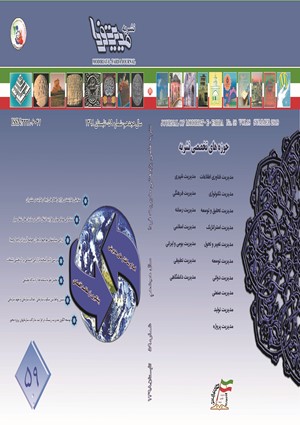ارايه یک مدل تلفیقی BSC - DEA با حضور وروديها و خروجیهای غير قابل كنترل برای اندازه گیری عملکرد
الموضوعات :
علی نمکین
1
,
سید اسماعیل نجفی
2
,
محمد فلاح
3
![]() ,
مهرداد جوادی
4
,
مهرداد جوادی
4
1 - دانشگاه آزاد
2 - دانشگاه آزاد
3 - دانشگاه آزاد
4 - دانشگاه آزاد
الکلمات المفتاحية: كارت امتيازي متوازن تحليل پوششي داده ها ارزيابي عملكرد,
ملخص المقالة :
استراتژي اصلي ترين منبع رشد بلند مدت سازمانها مي باشد و در صورت عدم اجراي موفق استراتژي ، حتي اگر استراتژيهاي مناسبي اتخاذ شده باشد اين فرآيند بيهوده است. در راستای اجرای صحیح و درست آن برنامه ها به غیر از جنبه های مالی بایستی از جوانب دیگری نیز سازمان ها به طور توام و همزمان مورد ارزیابی قرار گیرند كارت امتيازي متوازن كه بر چهار جنبه، مالي به عنوان نتيجه عملكرد گذشته (شاخصهاي گذشته نكر) و سه جنبه فرآيندها؛ مشتري و رشد و یاد گیری (شاخصهاي آيندهنگر) توجه دارد به عنوان یک چارچوب جامع ارزیابی عملکرد و پیشبرد استراتژی، مطرح می باشد .از طرفی می دانیم بسیاری از عوامل تاثير گذار بر سازمانها بعضاٌ از حيطه كنترل مديريت خارج مي باشد از اينرو حياتي است كه ميزان اين تاثيرات مورد ارزيابي قرار گيرد. روش تحلیل پوششی داده ها یکی از بهترین روشهای ریاضی برای محاسبه کارایی سازمان می باشد .یکی ازضعف های روش کارت امتیازی متوازن با وجود توانایی بالا در ارزیابی عملکرد ، عدم اندازه گیری کمی عملکرد سازمان با استفاده از روش ریاضی مي باشد برای حل این مهم از تحلیل پوششی داده ها استفاده شده است . در اين مقاله به تلفيق دو نظام ياد شده پرداخته و سعي شده است از BSC به عنوان ابزاري براي طراحي شاخصهاي ارزيابي عملكرد و از DEA به عنوان ابزاري براي ارزيابي عملكرد با وجود شاخصهاي غير قابل كنترل استفاده شود.
[1] Kaplan RS, Norton DP. .,(1996),” Translating strategy into action: the balanced scorecard. Boston, MA: Harvard Business School Press.
[2] Charnes A, Cooper WW, Lewin A, Seiford LM.,(1994),”. Data envelopment analysis: theory, methodology and applications. Massachusetts: Kluwer Academic Publishers.
[3] Kaplan RS, Norton DP. The balanced scorecard: measures that drive performance. Harvard Business Review, 1992(January–February): p. 71–9.
[4] Kaplan RS, Norton DP. Using the balanced scorecard as a strategic management system. Harvard Business Review 1996(January–February): p. 75–85.
[5] Fa¨re, R., Grosskopf, S., Whittaker, G., 2007. Network DEA. In: Zhu, J., Cook, W.D. (Eds.), Modeling Data Irregularities and Structural Complexities in DEA. Springer Verlag, New York, pp. 209–240
[6] Milis,K. and Mercken,R.,(2004),”The use of the balanced scorecard for the evaluation of information and communication technology projects”,International Journal of Project Management,Vol 22,pp:87–97.
[7] Karsak,E.E., Sozer,S. and Alptekin,E.,(2002),”Production Planing in quality function deployment using a combined …,”Computer and Industrial Engineering, Vol 44 ,pp:171–190
[8] Karathanos,D. and Karathanos,P.(2005),” Applying the Balanced Scorecard to education”, Journal of Education for Business,Vol 15,pp:222-230
[9] Wu, H.Y., Constructing a strategy map for banking institutions with key performance indicators of the balanced scorecard, Eval. Prog. Plan. 2012. 35(3): p. 303–320.
[10] Akbarian, M., Najafi, E., Tavakkoli-Moghaddam, R., & Hosseinzadeh-Lotfi, F., A Network-Based Data Envelope Analysis Model in a Dynamic Balanced Score Card, Math. Prob. Eng. 2015(2015): p.1-13.
[11] Carla, A.F.A., Sergio, P.S., & Pedro, M.M., Integrating the Data Envelopment Analysis and the Balanced Scorecard approaches for enhanced performance assessment, Omega. 2012. 40(3): p. 390–403.
[12] Javad Khalili , Alireza Alinezhad, Performance Evaluation in Green Supply Chain using BSC, DEA and Data Mining International, Journal of Supply and Operations Management,2018
[13] Somayyeh Danesh Asgari, Abdorrahman Haeri , Mostafa Jafari, Integration of Balanced Scorecard and Three- stage Data Envelopment Analysis Approaches, Iranian Journal of Management Studies . 2017


